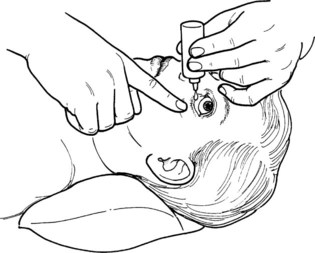This section may be photocopied and distributed to families. 2. Wash your hands with soap and water. Count to 10 while washing, then rinse with clear water and dry with a clean paper or cloth towel. 3. Remove any discharge from the eye with a clean tissue. Wipe from nose to ear. 4. If the eye has crusted material around it, wet a washcloth with warm water and place this over the eye. Wait about 1 minute. Gently wipe the eye from the nose side outward with the washcloth, place it on the eye, and wait again. If you cannot remove the crusting, rewet the washcloth. Then try to gently remove the crusted drainage. Continue using the warm, moist washcloth and gently wiping until all the crusting is removed. If both eyes need cleaning, use separate cloths for each eye. Launder the washcloth(s) before using again. 5. Have the child lie on his back on a flat surface. If the child will not lie still, you can hold the child by sitting on a flat surface such as the floor or bed. Place the child on his back with his head between your legs and his arms under your legs. If needed, you can cross your lower legs over the child’s legs to keep him from moving. Place a pillow under the child’s shoulders, or a rolled-up towel under his neck so that his head is tilted back and to the same side as the eye to be treated (right eye, turn head to right; left eye, turn head to left). The eye drops should flow away from the child’s nose. 6. Open the bottle of eye drops. Do not let the dropper portion touch anything. 7. Tell the child to look up and to the other side (away from the eye into which you are putting the drops). Choose something specific for the child to look at. If the child is young, you can make a game of giving the eye drops. Tell the child to open his eyes on the count of 3. Then count to 3. When you say 3, drop the eye drops into the child’s eye. Even if the child will not open the eyes on 3, keep him lying down until he decides to open the eyes. The medicine will flow in the eye. 8. Note that the wrist of the hand you will be using to give the drops is placed on the child’s forehead. This will help steady your hand. 9. Gently pull down the child’s lower eyelid with the other hand by placing gentle downward pressure below the eyelashes (Figure 1).
Wilson & Hockenberry: Wong’s Clinical Manual of Pediatric Nursing, 8th Edition
Patient Teaching Guide
Giving Eye Medications
Instructions for Eye Drops
![]()
Stay updated, free articles. Join our Telegram channel

Full access? Get Clinical Tree


Wilson & Hockenberry: Wong’s Clinical Manual of Pediatric Nursing, 8th Edition: Patient Teaching Guide
Get Clinical Tree app for offline access

